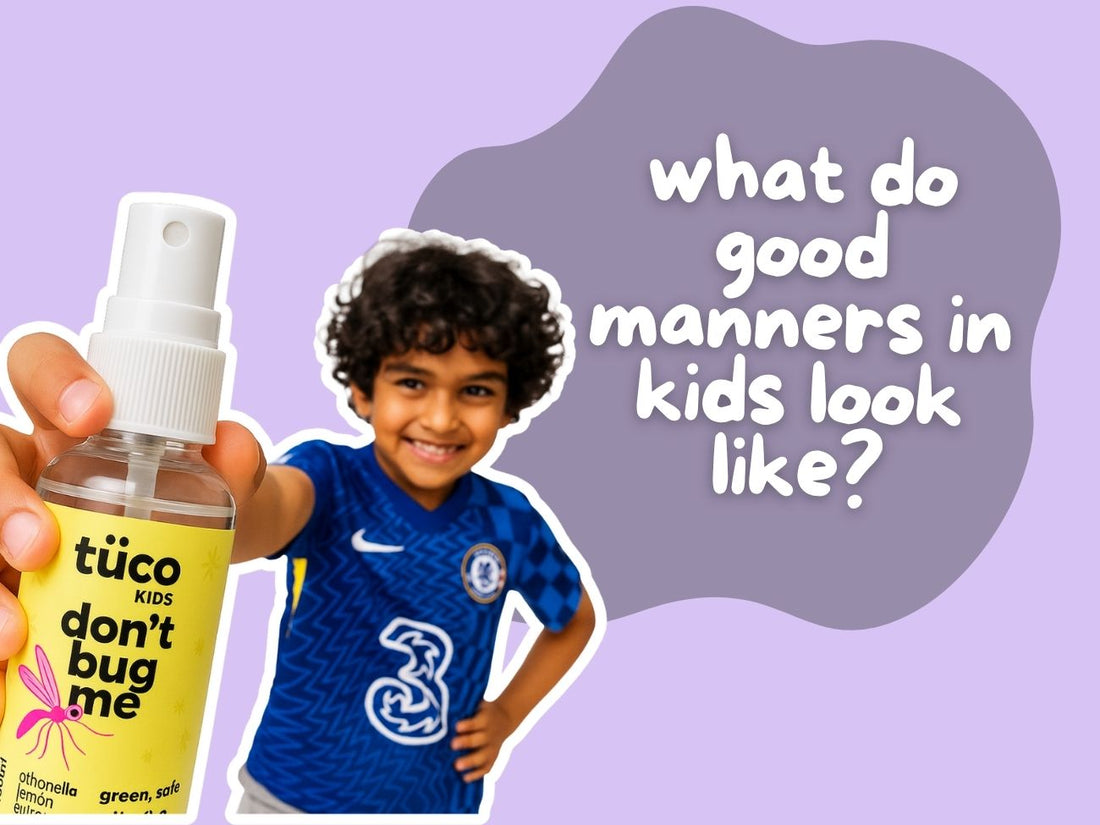
Good Manners for Kids: An Age-Wise Guide to Raising Polite, Confident Children
Share
Why Manners Matter
Good manners aren’t just about being “polite.” They are about empathy, respect, and emotional intelligence. They help kids form friendships, succeed at school, and navigate society with confidence. In today’s world — with digital interactions, cultural diversity, and new challenges — teaching manners is more important than ever.
Just as good manners teach children to respect others and themselves, everyday self-care builds confidence too. With Tuco Kids’ safe range of soaps, lotions, and shampoos made for ages 3–14, parents can encourage kids to practice politeness not only in words and actions but also in caring for their own bodies gently and responsibly.
Ages 2–4: Toddler Manners - First Steps Through Play
-
Politeness: Saying “please,” “thank you,” “sorry.”
Why it matters: Teaches toddlers that words can express respect and kindness.
How to teach: Use “magic words” games: pretend that “please” unlocks cookies or toys. Praise them immediately when they try.
-
Sharing & Taking Turns:
Why it matters: Reduces tantrums, builds empathy.
How to teach: Use toys to role-play sharing. Say: “Teddy shares his blocks with Bunny. Can you try?”
-
Table Manners: Eating without throwing food, learning to use a spoon.
Why it matters: Introduces mealtime discipline early.
How to teach: Use small utensils and let them “practice.” Reward them when they finish without mess.
-
Bedside Manners: Saying “goodnight,” tidying up toys before sleep.
Why it matters: Builds routine and gratitude.
How to teach: Create a bedtime ritual: tidy toys, brush teeth, hug parents, say “goodnight.”
-
Digital Manners: Understanding “no screens at meals” or before bedtime.
Why it matters: Prevents dependence on gadgets.
How to teach: Create “tech-free zones” (bedroom, dining table). Use fun signs like “Table is for food, not for phones.”
Raising confident, well-mannered kids means teaching them kindness in everyday routines. Tuco Kids supports this journey with safe, age-appropriate products that make self-care a natural extension of good manners.
Creative Tuco Tip: Make a Manners Storybook — Draw stick figures showing a child saying “please” or tidying toys. Toddlers will learn visually.
Ages 5–7: Preschool & Early School - Group Social Manners
-
Morning Routine Manners: Greeting parents and teachers with “Good morning.”
Why it matters: Builds respect and positive energy to start the day.
How to teach: Practice greetings at home: role-play school mornings.
-
Table Manners: Chewing with mouth closed, using napkins, waiting for everyone before eating.
Why it matters: Sets the foundation for polite dining in groups.
How to teach: Play “restaurant” at home. Assign roles: child is customer, parent is server. Practice polite ordering and eating.
-
Politeness & Respect: Using “excuse me” to interrupt, respecting elders.
Why it matters: Teaches social awareness.
How to teach: Use fun drills: “Pretend I’m busy — how do you get my attention politely?”
-
Sharing & Kindness: Offering snacks, toys, or helping friends.
Why it matters: Builds empathy and teamwork.
How to teach: Read fables (like “The Lion and the Mouse”) and ask, “How did kindness help here?”
-
Safety Manners: Looking both ways before crossing, staying close to adults.
Why it matters: Links manners with personal safety.
How to teach: Play “red light, green light” to practice stopping before crossing.
-
Digital Manners: Asking before using devices, no shouting at voice assistants.
Why it matters: Builds respect for shared technology.
How to teach: Use a family “digital contract” with stickers as rewards for following rules.
Creative Tuco Tip: Create a “Manners Jar.” Drop in a bead whenever your child shows kindness or politeness. At the end of the week, reward with a special activity.
Ages 8–10: School-Age Kids -Respect, Responsibility, and Awareness
-
Politeness in Speech: Using “May I,” “Could you please,” “Pardon me.”
Why it matters: Expands vocabulary for respectful communication.
How to teach: Play “Politeness Bingo.” Each time they use polite phrases, they mark off a box.
-
Table Manners: Passing dishes, not reaching across, thanking the cook.
Why it matters: Teaches gratitude and patience.
How to teach: Give them the role of “table captain” — they ensure everyone gets served politely.
-
Formal Manners: Introducing themselves confidently, handshakes, eye contact.
Why it matters: Builds confidence in social settings.
How to teach: Practice introductions at home: “Hello, my name is ___, nice to meet you.”
-
Informal Manners: Respecting friends’ belongings, avoiding teasing or exclusion.
Why it matters: Strengthens friendships and builds empathy.
How to teach: Ask reflective questions: “How would you feel if someone laughed at your drawing?”
-
Environmental Manners: Throwing trash in bins, saving water, switching off lights.
Why it matters: Builds global responsibility.
How to teach: Make chores eco-fun: “Can you be today’s Light Switch Superhero?”
-
Digital Manners: No devices at the dinner table, no mean comments online, respect privacy (not posting pictures of others without asking).
Why it matters: Prepares them for safe digital citizenship.
How to teach: Show examples of “good” vs. “bad” online behavior with cartoons or memes.
Creative Tuco Tip: Introduce a “Compliment Circle” at family dinners. Each person gives one polite compliment to someone else — builds positive communication.
Ages 11–13: Pre-Teens -Real-Life Etiquette and Digital Responsibility
-
Table Manners: Proper cutlery use, waiting for the host, offering to help clear the table.
Why it matters: Prepares for formal events.
How to teach: Host a “Formal Dinner Night” at home. Practice with extra forks, napkins, and serving dishes.
-
Formal Manners: Writing thank-you notes, polite email beginnings, addressing teachers respectfully.
Why it matters: Develops professionalism early.
How to teach: After birthdays, encourage handwritten thank-you cards.
-
Informal Manners: Respecting privacy, not gossiping, resolving conflicts calmly.
Why it matters: Builds healthy friendships.
How to teach: Use role-play: act as a friend who is upset, and let your child practice comforting words.
-
Public Manners: Speaking softly, waiting in queues, offering seats to elders.
Why it matters: Encourages community awareness.
How to teach: During outings, point out examples of good manners (“See how he held the door open?”).
-
Digital Manners: Respecting screen time rules, asking before tagging or sharing pictures, avoiding cyberbullying.
Why it matters: Online reputation starts early.
How to teach: Create a “Family Tech Contract” — include screen-time limits, online kindness rules, and family check-ins.
-
Financial Manners: Thanking when given money, saving instead of demanding more.
Why it matters: Builds gratitude and responsibility.
How to teach: Teach them to divide allowance into jars: Spend, Save, Share.
- Creative Tuco Tip: Keep a “Politeness Journal.” Encourage them to write one kind act they did each day. Review together at week’s end.
Ages 14–15: Teens - Social Etiquette, Respect & Character
-
Table Manners: Napkin use, no phones at the table, complimenting the host.
Why it matters: Prepares them for social gatherings and interviews.
How to teach: Organize a family dinner where teens lead the etiquette.
-
Formal Manners: Polite introductions, handshakes, writing formal emails.
Why it matters: Builds communication confidence for adult life.
How to teach: Practice “mock interviews” at home with introductions and questions.
-
Manners with Friends: Respecting opinions, no peer pressure, kindness during disagreements.
Why it matters: Builds trust and strong friendships.
How to teach: Discuss real-life situations where peer pressure happens. Role-play safe responses.
-
Digital Manners: Understanding digital footprints, responsible social media use, fact-checking before sharing.
Why it matters: Teens’ online actions affect future opportunities.
How to teach: Share stories of online missteps and their consequences. Encourage them to “pause before posting.”
-
Community Manners: Volunteering, greeting neighbors, not littering.
Why it matters: Teaches responsibility toward society.
How to teach: Involve them in community drives (tree planting, clean-ups).
-
Emotional Manners: Apologizing sincerely, expressing gratitude, respecting personal space.
Why it matters: Builds emotional intelligence.
How to teach: Encourage journaling, gratitude lists, and calm family discussions.
Creative Tuco Tip: Encourage your teen to mentor a younger sibling in manners — teaching reinforces their own learning.
Creative Ways to Teach Manners
-
Role-Play Scenarios: Pretend to be a waiter, teacher, or new friend. Kids practice manners in safe play.
-
Storytelling & Cartoons: Choose stories where kindness and politeness solve problems.
-
Manners Jar: Drop a bead for every polite act. Weekly reward = extra playtime.
-
Compliment Game: At meals, each family member compliments another.
-
Digital Contract: Write and sign rules about respectful online use.
-
Visual Reminders: Posters, flashcards, or stickers with “magic words.”
-
Model Behavior: Parents should demonstrate what they expect.
- Community Practice: Use outings to highlight manners in real life.
Manners are not old-fashioned — they are timeless life skills. From saying “please” at age two to understanding digital footprints at fifteen, every stage offers parents a chance to raise children who are polite, respectful, and emotionally intelligent.

